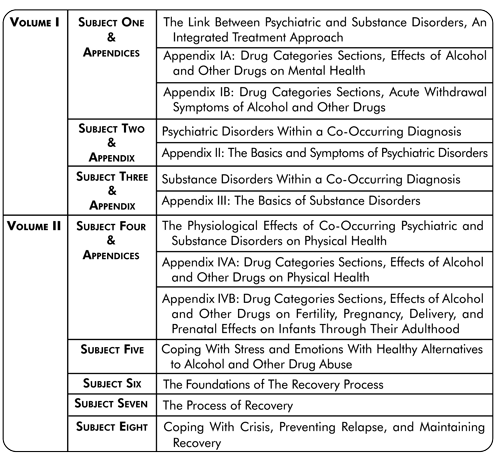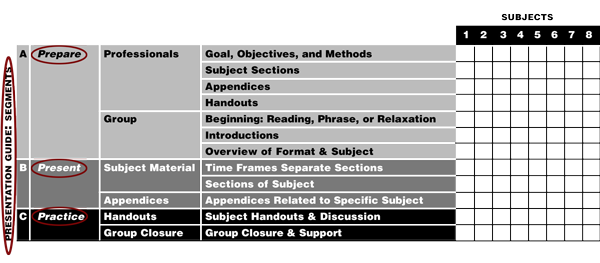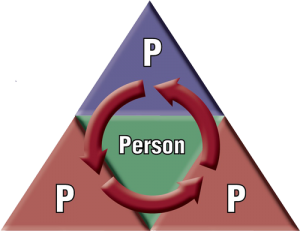SEGMENTS: Presentation Style – Prepare, Present, Practice
Every subject is divided in a presentation style of three segments of Prepare, Present, and Practice (Rhonda McKillip: McKillip and Associates © 2004). Each segment has very explicit purposes in facilitating psychoeducation content and creating a cohesive, helpful, and educational group atmosphere where a person can internalize the information presented to them in the group process.

Master Procedural Guide

The presentational guide: segments of THE BASICS, Second Edition is located in the beginning of Volume I in the Master Procedural Guide for Professionals under the title Segments: Presentational Style. It’s also found in the first page of every subject – after the subject table of contents – in the Presentation Guide for Professionals.
The style of Prepare, Present, and Practice are outlined at the beginning of each subject in the presentation guide as follows (G. Dunbar, personal communication, August 30, 2002):

Book Review Excerpt:
“Each subject starts with a Presentation Guide, which is organized into three segments (Prepare, Present and Practice) and then further broken down into areas pertaining to the professional and the group, subject materials and appendices, handouts and group closure. Data presentation is based on sound clinical approaches such as “stages of readiness for change” theory. In addition, the author leads you through appropriately maintaining measurable goals and objectives. Participants’ strengths, cultural diversity, diagnosis, functioning level, and severity and acuity of specific disorders are considered.” Lindsay Freese (Professor of Human Service at New Hampshire Technical Institute; Addiction Professional Magazine: What’s Working in Treatment and Prevention, May 2005, A Co-Occurring Curriculum That’s Worth Its Weight)

This Prepare, Present, Practice presentation was designed to create a group format that surrounds the person with a style and approach that helps create an atmosphere where learning, sharing, discussing, and connecting can be encouraged.
Prepare
First, Professionals Prepare Themselves by…
- Reviewing the subject goals, objectives, and methods – as well as the subject, appendices, and handout content related to the subject being taught.
- Deciding beforehand the key points to be covered in group. This helps with flexibility for group discussions or answering questions. For example, if you intend to cover ten pages in a group session then review those ten pages for key points. It’s always more important to allow group members to discuss the material than covering all ten pages.
- Paying particular attention to the sections of “Tips to Professionals” throughout each subject and the “Master Tips to Professionals” located at the back of Volume I. The tips offer valuable information that’s specific to providing integrated treatment to people with co-occurring disorders. The tips will reinforce things you already do and may provide some new treatment ideas as well.
Taking a few minutes to prepare before group assists the facilitator in begin able to skip forward to highlight key points in a particular subject. In other words, if the group’s desire to productively discuss a specific point or subject goes twice as long as you thought it might – then jump ahead to your key points. You would still end the material presentation within the suggested time frame to allow for group interaction, exercises, and positive group closure.
Second, Professionals Prepare The Group by…
- Briefly explaining the format of each group, such as the division into sections, the subject or main points you’ll be discussing, break times, and especially the fact that time will be devoted to handouts and/or discussion, as well as positive group closure and support.
- Explaining the subject or main points to be discussed can also be done by reading the “Today’s Subject and Why It’s Important” found in the beginning of each subject. If that section is not relevant, you can still begin every group by telling participants what the subject for the day is and especially why it is important.
- Informing the group about key points of the particular subject will also provide the relevance or importance of specific material to their recovery. It can also be helpful whenever you may need to skip ahead to the key points in the group content presentation when necessary.
Group structure can help relieve the typical anxiety related to just being in a group, particularly for people with co-occurring disorders. Plus most of us generally appreciate knowing this type of information when we are attending a class or conference. And if nothing else, it’s the respectful way to let people know what to expect in each and every group session.
Pretty much every health professional has structure. We sign in, we wait, we get called back, we wait, we tell the assistant with the computer why we are there, we wait…well you get the idea. Structure is important when receiving services.
Present
Book Review Excerpt:
“The curriculum includes ‘Tips to Facilitators’ placed throughout the text regarding recommendations for exactly how to present the materials, augmenting the data with the use of included handouts, and various appendices containing additional topic information as well as hints. These hints pertain to presentation style, such as using visuals, allowing adequate time for the review of handouts, and making generous use of empathy and hope.” Lindsay Freese (Professor of Human Service at New Hampshire Technical Institute; Addiction Professional Magazine: What’s Working in Treatment and Prevention, May 2005, A Co-Occurring Curriculum That’s Worth Its Weight)
Professionals present the subject material to be learned in the group. In the Lesson Plans you will find a format designed to provide a group structure of:
- Positive Group Beginning
- Summarize Introduction of the Group Topic and Why It’s Important
- Psychoeducation Content
- Presentation Suggestions To The Facilitator
- Suggested Process Questions To The Group Regarding the Lesson Topic and Content
- Skill Building Exercise and Discussion
- Crisis Processing When Applicable (explanation of this is located in the first page of every lesson plan under the heading Psychoeducational Groups and Crisis Event Processing (when requested)
- Group Closure
Interactive Style
You are doing exactly what this curriculum was designed to do if you are devoting at least 1/3rd or 1/2 of group time to interacting about the content, working through the Worksheet Handout, and/or discussing the Inspirational Handout
Interacting Promotes Change
An interactive facilitation style helps people individualize, personalize, internalize, and implement the subject material. If education was all that was needed, people could be given books to read and that would be that – no more Psychiatric or Substance Disorders – and no need for treatment facilities.
Interaction encourages group participants to learn at their own pace, based on their own:
- Functioning Level
- Readiness for Change
- Personal Motivation
Interacting with others helps group members incorporate new skills, behaviors, and tools into their personal recovery plan by trying them out in the group process. Just to restate, the presentation of material is designed for interaction through the use of recommended group discussions, worksheets, and handouts.
Lecturing Is Not Interacting
It’s essential to never lecture to the group. THE BASICS, Second Edition is actually written in a way that it can be read to the group. It is written in conversational language and to the person in group. Yet the focus on interaction – which is literally written into the lesson plan formats – is still different than a straight lecturing style that’s void of any interaction with the group itself.
An example would be presenting on the topic of Anger and the different ways each person expresses their anger. Each psychoeducational topic is important information to be learned – like anger management or symptom management. Yet, if the group ends there – how will a person actually benefit from just the education. It is the processing of the content with discussions that can be prompted by questions which might include: (remember topic processing suggestions to choose from are included throughout each of the Lesson Plans)
- What messages did you learn when you were growing up about expressing anger? Was it considered a strength? A weakness?
- How do you personally express your anger? Stuff it? Rage? Take it out on someone else? How?
- Are there times you think you might improve the way you express your anger? What would you do differently?
- Is there a particular person that is especially difficult for you to express your anger to? How would you like to change that?
While all subjects contain a wealth of information, it’s not intended to overwhelm the professional or the group. You can avoid a lecturing style by becoming familiar with the material beforehand. Ample information is designed to actually give you the opportunity to cover some sections in depth or skip others altogether – depending on the interests or needs of your particular group. As you read over the material beforehand, you’ll gain an overall understanding of the content. You may then paraphrase, summarize, and hit the highlights.
Becoming familiar with the material before the group is particularly important when it comes to the Drug Categories Sections in the Appendices in Subject One and Subject Four. Simply reading a list of the possible medical complications or other appendix content is not helpful to group participants. However, when a facilitator becomes familiar with these sections prior to group, they gain an overall pattern of the effects of specific drug categories like cocaine or alcohol for example.
Familiarizing yourself with these sections prior to group will give you an overall pattern of the effects of specific drug categories. This will give you a good idea of how to summarize the material in your own words. For instance, you may talk about how cocaine is particularly bad on the heart or how alcohol irritates every system of the body, etc.
You may also engage the group by asking them how specific drugs have affected their mental, emotional, and physical health to this point. Then you may discuss what problems each person might avoid with continued recovery – like keeping anxiety from becoming a crisis or avoiding more severe stomach problems or lessening the chance of depressive episodes becoming more severe.
Practice
I hear and I forget; I see and I remember; I do and I understand.
Ancient Chinese Proverb
The practice of the subject material, which includes the handouts and group discussion, as well as the group closure and support, also helps participants internalize and personalize the subject material.
Handouts
From Rhonda McKillip: Professionals and treatment professionals have typically had to use multi-generalization, hard to read, printed off-center, and uninteresting handouts. That is completely understandable since staff with large caseloads generally don’t have the time to chart…much less create handouts for groups. One of my curriculum goals was to make a change. The handouts all have abundant information, graphics, humor, spiritual or heart-warming information and much more. Regards, Rhonda
All handouts in the curriculum are designed to provide education in two different ways. One is through the Worksheet Handouts where group participants can practice specific skills by filling out the questions on the handout and then by sharing these with others. The second is the Inspirational Handouts designed to provide encouragement in the form of inspiration, humor, or wisdom. Inspirational Handouts can also be read as positive reading in the Group Closure.
From Rhonda: As a group facilitator, for years I: (1) I tried to preserve a good quality handout for reproduction for group; and (2) waited in line to make copies of handouts prior to group; and (3) ended up throwing away the excess copies when the group was less than the handouts I had copied or tried to save them for the next group when it cycled around again, and (4) wished handouts provided education a well as interesting format with graphics. I finally developed a way to manage these struggles. You will find Tip #39 “Suggestions for Managing Handouts For Groups” located at the end of Volume I in the Master Tips to Professionals. It worked so well for me, as well as other treatment providers that I included it in THE BASICS, Second Edition. Hopefully it is helpful to you as well. Sincerely, Rhonda
Both Worksheet and Inspirational Handouts are also designed to provide education on specific subjects and most have spaces to write on or boxes to check to identify how the content applies to each person. All handouts are written to involve the group in productive conversations and are an important part of every group – whatever the length of the group session. Again, the discussion of the handouts or interaction about the subject is intended to take one-third to one-half of the total group time.
From Rhonda: I designed the 52 handouts in THE BASICS, Second Edition with the notation at the bottom of Permission to Reprint Granted to Individual Purchaser of Curriculum. I also designed each handout page with additional space on the binder side for ease in placing the book on the copy machine in order to print the handout. If you decide to implement the “Suggestions for Managing Handouts for Groups” then you will only need to copy each handout one time to preserve the quality of the handout for future copying. Best wishes, Rhonda
Group interaction will, and should, determine the amount of time you spend on actual subject content. This is not to imply that the subject material is not important, it is very important to educate people about their illnesses and the recovery process designed to stabilize these illnesses. But simply being informed is not the same as being in recovery.
Interacting and connecting with others, receiving and giving constructive feedback or support, or socializing and communicating with others are just more important. This means the interaction time with the handouts should never be sacrificed so more education can be provided.
Group Closure
Studies show that when a group – or gathering like an AA group – is ended in a positive way that the group reports a more hopeful response of their group experience. There are many ways to end the group in a positive way that can include:
- Read the thought for the day from any of the numerous Day-At-A-Time books.
- State something to be grateful for.
- Share something learned today that will begin to be practiced outside of group.
- Offer support to a struggling group member.
- Read the Inspirational Handout for the particular group.
- State something that will be done today to protect recovery.
- Name something each person is grateful today.
You are what you think and feel, think only the best!